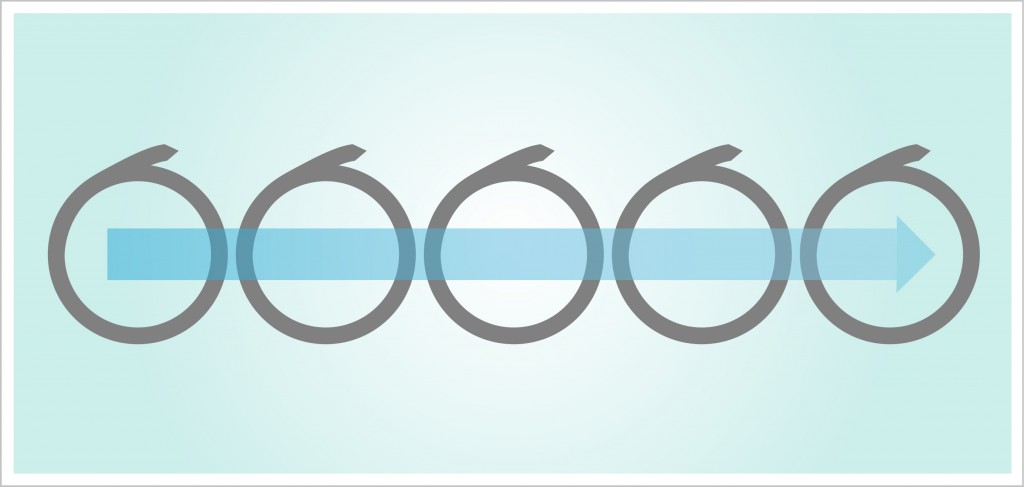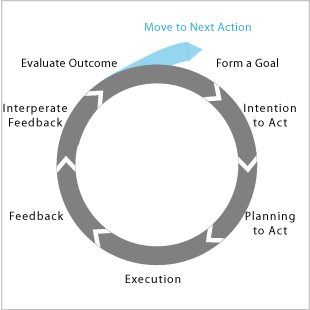April 8, 2011

Beyond my work with the Human Factors team at Qwest, I teach a graduate class at the University of Denver. Regularly our class engages in conversations around Don Norman’s Action Cycle.
Recently, Interaction-Design.org posted a video of Norman from the early 90’s. It seemed timely, for me anyway, so I thought I’d post an illustration I created of the Action Cycle.
Norman’s Action Cycle describes how humans interact with computer systems. Think about how we, as humans, interact with various interfaces (such as a website, a smart phone, an ATM machine, etc).
The illustration I’ve created (below) helps me to visualize the Action Cycle process. I’ve represented the cycle as a circle as users may have to repeat the cycle for the same action. This illustration also affords the user the ability to move out of one action cycle and onto the next. That is, to begin another action. See how Norman illustrated the Action Cycle in his book here. Below, I’ve listed the steps of the Action Cycle and included the example scenario Norman uses in his book The Design of Everyday Things.
Norman’s Scenario: A person wants to read a book

Forming a Goal
I can’t read my book because the room is dimly lit. I need more light in order to read my book.
Intention to Act
There is a light next to my chair. Turning on the light would allow me to read my book.
Planning the Action
I need to reach over and turn on the light.
Executing the Action
I reach over to turn on the light.
Feedback from the Action
The light turns on.
Interpret the Feedback
I am now able to see the text and can read my book.
Evaluate the Outcome
Positive – I’m able to read my book. No further action is needed.
Negative – The light doesn’t work. The Action Cycle is either repeated or a new goal is formed.
In terms of human-computer interaction, the desired scenario for a well-designed product is for a user to complete the Action Cycle a single time for a single action. If the user is required to repeat the Action Cycle multiple times for a single action, the result is pain and frustration.
Gulf of Execution and Evaluation
Norman goes on to describe two areas where poor design fails to support the user’s expectations.

Gulf of Execution
The Gulf of Execution exists when a user is having difficulties determining how to execute a goal. Let’s say a user is attempting to purchase an item from an online store. She sees an item she’d like to purchase and wants to put the item in her shopping cart. Unfortunately there is seemingly no interface element (e.g. a button, icon, checkbox, etc) which allows her to execute the action of adding the item to her cart. Having an online store where users have difficulty adding items to their shopping cart is clearly a failure in the interface and detrimental to the company’s goal of selling products.
Gulf of Evaluation
The Gulf of Evaluation occurs when a user has trouble assessing the state of the system. Simply put, the user is expecting feedback from an action and not receiving (at best) what they expected or (at worst) nothing at all. A simple example:
- Add an item to your online shopping cart
- Press the “Checkout” button
- Wait …
- Press the “Checkout” button again
- Wait again …
- Begin to scan the page to see if anything is happening …
- The user experiences pain and frustration
- The system has failed
Above, I’ve detailed fairly simple examples. There’s certainly much more that can be said, studied and learned from Norman’s Action Cycle. Should you be interested in learning more I’d suggest beginning with Norman’s The Design of Everyday Things
